Many people can’t rest until their grass is a uniform shade of green and thick. After all, a well-kept lawn is often viewed as a symbol of status and luxury. Standard grass lawns, however, require a lot of maintenance and upkeep.
So why not replace your lawn with something less demanding while also making it more friendly to pollinators and other wildlife? Well, that is where flower meadows and wildflower lawn come in!

Wildflower lawns are pollinator-friendly, low-maintenance, and require little water and mowing.
A wildflower meadow is a beautiful and sustainable alternative to traditional lawns that can provide visual appeal for several months every year. Wildflower meadows are quickly becoming a “must have” feature in every yard and garden.
It is a great way to introduce colors and biodiversity to your home. So, if you are also tired of your typical grass lawn, why not consider establishing a lively, eco-friendly wildlife haven instead?
Establishing a wildflower lawn is easy! Simply walk across the ground, scattering your wildflower seeds at the suggested rate. Spread the seeds evenly so they can grow and blossom well. There is no need to rake or bury the seeds. Just walk on them lightly! It is sufficient to provide good seed-to-soil contact.
Next, water the seeds, and soon you will have a colorful lawn full of bees, birds, and beetles!
That said, there is a lot more to wildflower lawns than meets the eyes.
Read on to find out!
What Is A Wildflower Meadow?
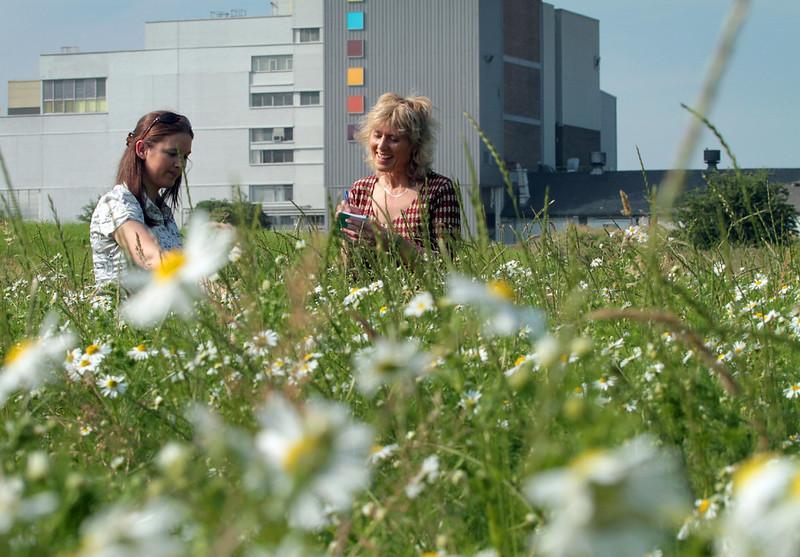
Wildflower meadows offer a diverse and beautiful habitat for the pleasure of both young and old alike.
A wildflower meadow is a garden that consists of native grasses, plants, and flowers that thrive well together.
It is a community of several plant species, including annuals, biennials, and perennials, that have been carefully nurtured to thrive in your local environment.
Once you have even a tiny wildflower meadow in your yard or garden, you will be amazed by the variety of insects, bees, birds, and other beautiful creatures it can attract. Combining well-kept grass with a patchwork of wildflowers is a sight to see.
There is something about the change in height, texture, warmth, and motion between these two structures that attracts me. In addition, wildflower lawns somewhat relieve homeowners of the need to trim their grass and do other chores associated with lawn maintenance.
Why Grow A Wildflower Lawn?
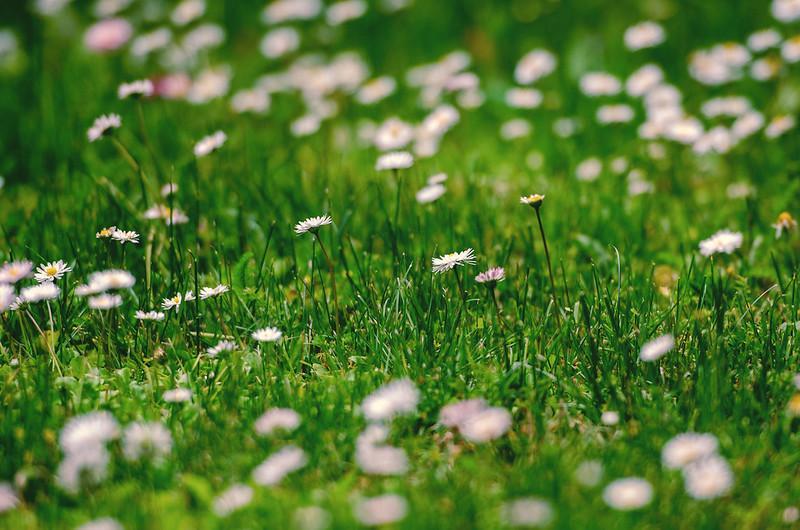
Wildflower lawns not only need fewer resources, but they actually improve the environment.
Manicured lawns are bad for the environment for a variety of reasons. For instance, they require a high volume of pesticide application, which can harm wildlife and the natural environment. Moreover, they also need a lot of fertilizer, which raises the possibility of chemical runoff into the soil and surrounding water supplies.
Wildflower lawns, on the other hand, require less or do not require any of these things at all. That’s also why eco-gardeners adore them: they’re great for the environment.
However, there is a lot more value to having a wildflower meadow or a wildflower lawn in your home or backyard. For instance:
- Wildflower meadows attract insects and birds, both of which contribute to the creation of your very own wildlife sanctuary by pollinating other plants.
- Wildflowers are hardy plant species that can flourish in a wide range of conditions. They actually tend to do better when grown in poor soil!
- By selecting the right wildflowers for your area, you can restore the biodiversity that has frequently been destroyed in grassy lawns.
- The random pairings of blooms in wildflower meadows lend an air of intrigue and variety to the home or garden landscapes.
- Colorful wildflower lawns are a beautiful addition to a garden that is usually either blandly green or unevenly brown.
- Wildflower meadows make your outdoor space smell more enticing by introducing a wider variety of appealing scents.
- A wildflower lawn beautifully emulates the look of a summer meadow.
- The use of wildflower lawns works wonderfully with cottage gardens.
- Maintaining a wildflower lawn is easier than a traditional lawn.
Related: How To Fix A Patchy Lawn? Steps, Tips & Tools Needed | A Comprehensive Guide
How To Plant A Wildflower Meadow?
While wildflower lawns are certainly low-maintenance, if you decide to grow one from scratch, you will need to do some preliminary work.
However, do not worry. We have got you covered!
If you simply comply with the directions that are provided below, you will have a wildflower meadow up and running in no time at all!
Remove Existing Grass
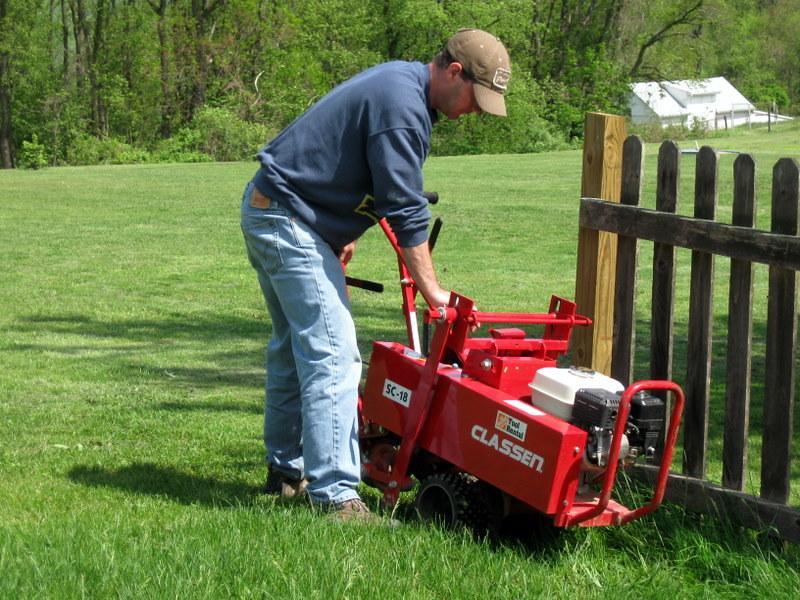
Using a sod cutter is one of the quickest and easiest ways to eliminate the existing grass on land.
Since wildflowers do not compete well with wildflowers, any existing vegetation must be cleared before wildflower seeding/sowing can take place.
It is not required to eradicate a grass lawn entirely before developing a wildflower lawn. However, the better prepared your yard is before planting, the greater your chances of establishing a lovely meadow will be.
The grass that already exists in a yard or garden can be removed in various ways. However, using a sod cutter or smothering the lawn with a black plastic sheet are two of the most straightforward and standard methods people often imply.
Deciding between the two requires weighing the costs of both time and effort. Smothering the grass or an entire lawn can take anywhere from two to three months, but once it’s done, you will not need to conduct any extra tilling.
On the other hand, cutting sod is a chore that can be accomplished in a single afternoon. However, afterward, you will need to till your soil.
Related: How To Mow Tall Annoying Grass On Your Lawn? A Comprehensive Guide
Get Rid Of The Weeds
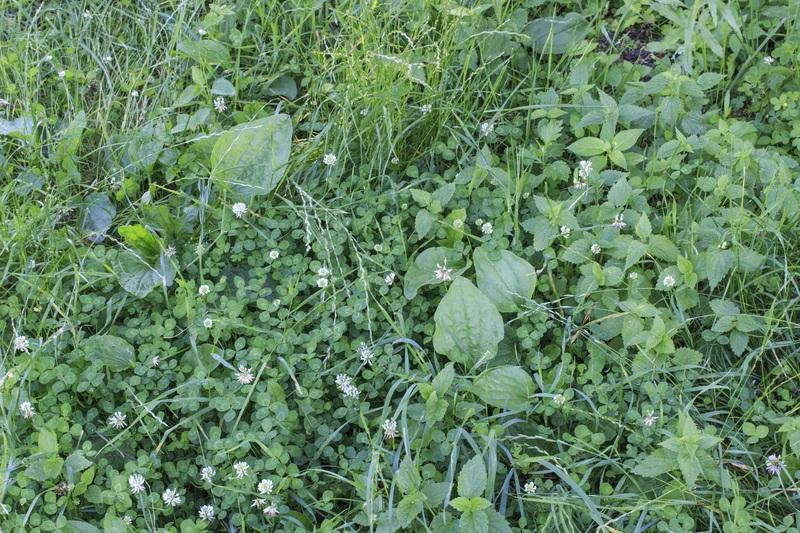
Weeds can be removed either manually or using a system herbicide on the land.
Do not be followed into believing that your lawn is free of weeds just because the soil is tidy and devoid of any vegetation. Your field probably has weed seeds dormant beneath the surface, waiting for their chance to emerge and take over the area.
For weed control in smaller areas, you can either remove the weeds by hand or cover the area for at least three months with black plastic or a weed-suppressing membrane before sowing.
For larger areas, however, you will either need to till the soil or apply a pesticide in addition to tilling in order to protect your meadow from invasive weeds.
Most of the time, tilling the earth is an outstandingly effective method for removing weeds. However, if your land is infested with perennial weeds, you will need to apply a herbicide in addition to tilling the soil in order to eliminate the weeds.
To get rid of the vegetation that is already present in your yard or garden, you can also give a non-residual systemic weedkiller that contains glyphosate a try. After using herbicide, do not till the soil as it will encourage more weed growth.
Prepare The Soil
Give the soil at least four to six weeks to set and for any weed seeds to germinate before continuing. Before you plant new seeds, hoe any new growth off the land.
Do not incorporate manure or fertilizer into the soil since high fertility causes grasses to have an unhealthy amount of vigor, which subsequently smothers the native wildflowers.
After the area has been cleared of vegetation, prepare a seedbed for a new lawn by digging or rotovating the soil while raking and compacting it for the seeds.
Choose The Type Of Meadow You Want
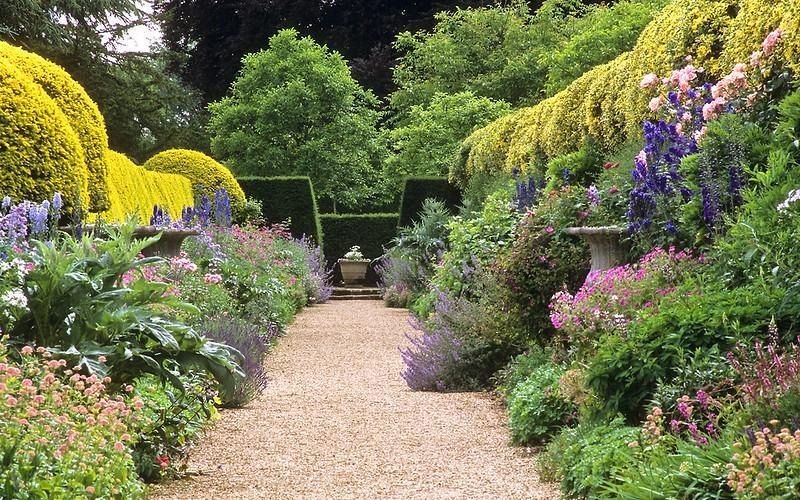
Perennial meadows perform best in places with poor and nutrient-deficient soils.
It’s crucial to pick the type of meadow that will thrive in your area. Annual meadows, which are typically seen in cornfields, require nutrient-rich soils.
They’re an excellent choice for when you want to transform an existing border between a lawn and any other structure into a wildflower meadow.
On the other hand, perennial meadows do best in areas with poor soils since the grasses there have less chance of out-competing the wildflowers.
However, if the soil underneath is rich, you should remove the top layer and seed directly into the subsoil that has been excavated or rotovated.
Related: Nitrogen Vs. Iron For Lawn | Which To Use & When To Use It? A Comprehensive Guide
Choose The Seeds

When growing a wildflower meadow, choose seeds that are best suited for your local conditions.
Wildflower seed retailers sell many seed mixtures that comprise of both wildflowers and grasses that are adaptable to various locales and soil types.
Pick the one that best fits the conditions in your area. You can also tailor a wildflower mix to your lawn’s specific light and moisture requirements and soil composition.
However, if you prefer to purchase a large number of individual seed packets, you can find an abundance of wildflower seeds at your neighborhood gardening center.
Once again, the best flowers for your meadow will depend on the condition but have a look at these flowers to entice a flock of fluttering companions to your garden.
- Arroyo lupine
- Aster
- Black-eyed Susan
- Common madia (tarweed)
- Golden Alexander
- Goldenrod
- Gum plant
- Milkweed
- Purple coneflower
- Yarrow
Scatter & Sow The Seeds
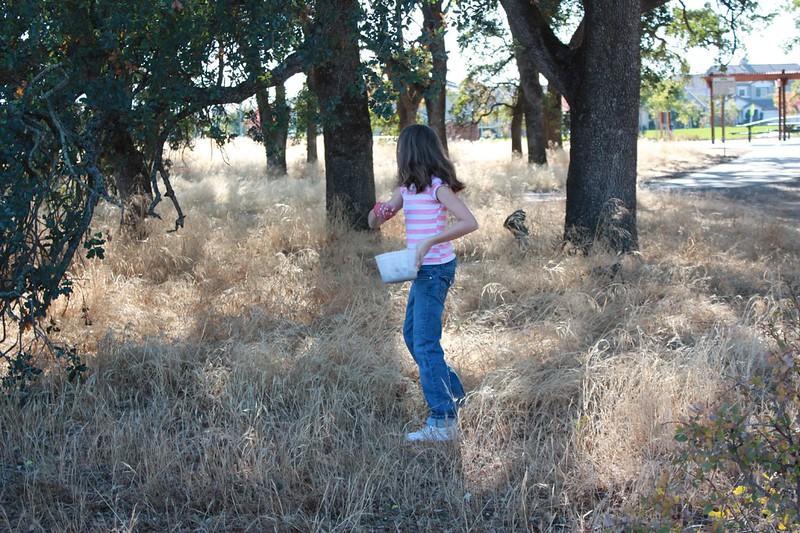
Mixing wildflower seeds with sand can help you spread them better over the area.
Once the soil has been prepared and the seeds have been selected, it is time to release your wildflowers lose into the world. If you want your seeds to sprout in the right spot, it’s best to scatter them on a day with no wind.
It is possible to sow even huge areas by hand with relative ease. Determine how much seed you will require based on the size of the seedbed.
The rates will vary depending on the combination, but as a general rule, you should sow pure wildflower seed at a rate of one gram per sq. meter and wildflower and grass seed mixtures at a rate of five grams per sq. meter.
Combine seeds and fine sand in a ratio of one-part seeds to four parts sand. Sand makes it easier to distribute seeds in a uniform manner, and because it is lighter in color than seed, you can still see how seeds are distributed across your lawn.
Spread your seeds all over the area using your hands and a continuous sweeping motion. In order to further ensure that the seed is distributed uniformly, you should sow half of it widthways and the other half lengthways.
Rake The Seeds
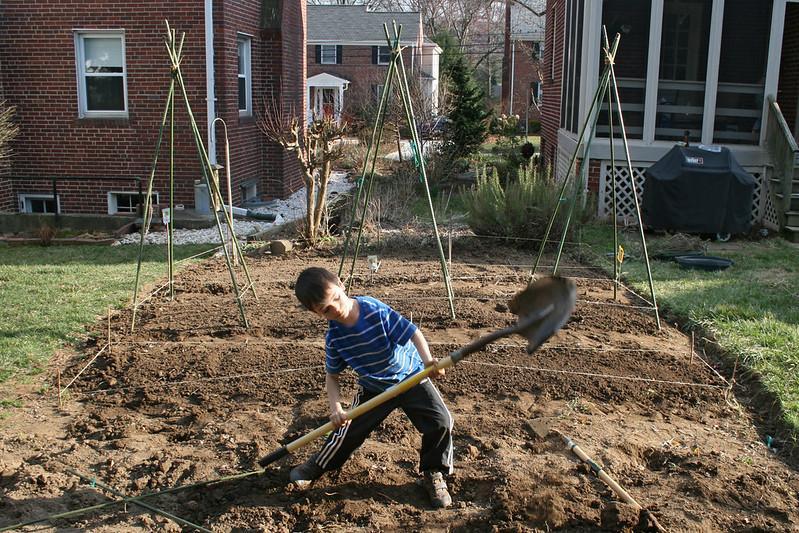
Raking the wildflower seeds helps them protect from birds and elements.
After you have dispersed your seeds, give the ground a light raking so the seeds can make good contact with the soil without being buried. However, if birds are a problem, you should be ready to safeguard the seed with netting.
You can also safeguard the seeds by covering them with a thin layer of straw mulch. When planting wildflowers on a hill, using a straw to protect the soil is extremely beneficial in preventing erosion and seed loss.
Aftercare
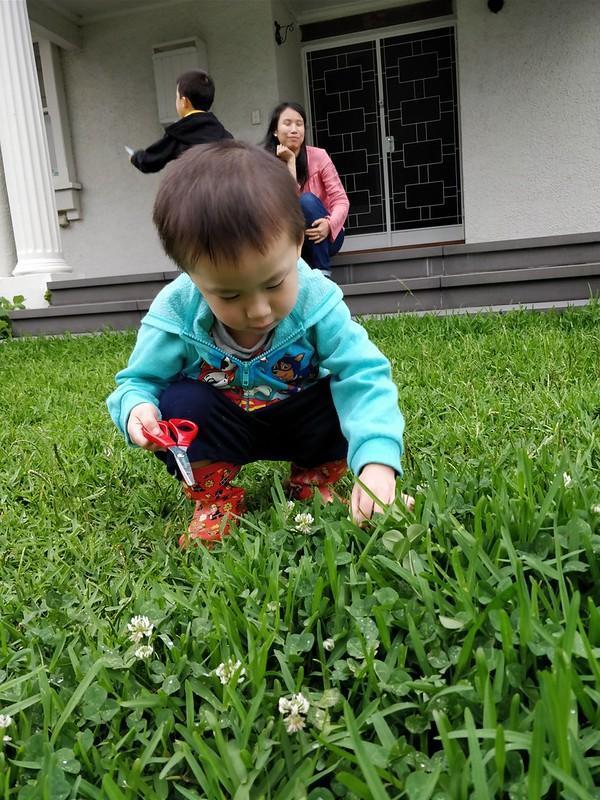
Do not use herbicides on your wildflower meadow. Just take a scissor and cut the weeds off.
Once the seeds start growing, there are a few things that you need to take care of!
Watering
After planting, make sure the soil is moist for the first four weeks. It is possible to water smaller areas during dry times in order to hasten germination, but more extensive regions will need to be left alone until the rains come.
The roots of adult wildflowers become longer and stronger with time, and as a result, the plants require less and less water as they grow.
Your meadow will become largely self-sufficient by the third year after you have planted it. It won’t require any further watering unless the weather is particularly dry.
Herbicides
Since herbicides can harm or kill wildflowers, you will need to manually remove weeds, cut them with shears or scissors, or spot-spray them to control their growth when they appear.
The most effective method involves cutting weeds with scissors or small shears. Simply cut their stems every other week just below the surface of the soil.
Mowing
Mowing your wildflower meadow in the late fall, after most of the flowers in the meadow have shed their seeds, will encourage new growth in the spring.
Never lower the blade setting on your mower to less than 6 inches since doing so might cause irreparable harm or even cause the grasses to die.
By doing this, you will also remove the dead flower heads from your wildflowers, allowing the plants to direct their energy toward producing new blossoms in the spring.
Your grass will naturally reseed itself if you leave the flower trimmings where they are.
Side Note: It is important to note that wildflower seed mixes and/or plants should not be planted in the wider outdoors or near environmentally sensitive areas.
When Should You Grow A Wildflower Meadow?
You should plant seeds in March and April or September, and this choice should be based on the type of soil. In general, seeds that are sown in the fall have a better chance of germinating and being established on lighter soils more quickly.
However, a few always do not emerge until the following spring. Due to this delay, it is recommended to wait until March or April before planting on heavy soils. This is because soil moisture can force the seed and seedlings to decay during the winter.
Establishing A Wildflower Meadow With Turf

A wildflower lawn works similarly to sod and can be used to create a wildflower meadow quickly.
Nowadays, wildflower turf, which is being offered by an increasing number of businesses and is delivered in short rolls in the same manner as traditional grass turf/sod, is gaining popularity. It is a viable alternative to spreading seeds on ground that is rich in weed seeds or in areas where rapid establishment or flowering is required.
Due to the higher costs, it is typically only appropriate for use in somewhat small wildflower projects. The ground should be prepared in the same manner as it would be for grass sod, with the exception of the use of fertilizer.
Moreover, even though it is feasible to plant wildflower grass at any time of the year, the optimal time to do so is typically in the spring.
Side note: While some providers may employ plastic mesh to strengthen their grass, you may now find wildflower turf grown on a plastic-free felt foundation.
Is Wildflower Lawn Worth It? Wildflower Meadow Pros & Cons

Although a wildflower lawn looks excellent, weeds can quickly overtake it.
It is in your best favor to think about both the pros and cons of having a yard full of wildflowers before deciding to plant a wildflower meadow.
| Pros | Cons |
| Beneficial to the various species of pollinators. Enhances the natural color of your landscape. Fosters biodiversity.Helps cut down on pollution due to runoff & erosion. Low-maintenance.Protects and improves the health of the soil. There is minimal to no need for toxic chemicals. | Ample lawn space is required. It cannot withstand a lot of foot traffic. Compared to conventional grass, it is messy. Quickly overtaken by weeds. It takes time for plants to blossom and grows strong. Most wildflowers require full to partial sun. Not an excellent place for children or pets to play. |
Converting A Lawn Into A Meadow
It is possible to transform any lawn into a wildflower meadow. However, it may take several years for the proper ratio of grass to wildflowers to become established in the area.
So, here are a few things to keep in mind:
- Many wildflower vendors sell plug plants, which are little individual plants that can be planted directly into an existing lawn. Planting the same species in close proximity to one another creates a more natural appearance.
- There will be some native species that will take root and flourish during the first year.
- Raise the remaining plants from seed and introduce them as one- to two-year-old potted plants that are then placed into holes in the turf.
- Maintaining a weekly mowing schedule over the first year will further hinder the grass and give wildflowers a better chance of establishing themselves.
- After you have planted wildflowers, you should also cease feeding the grass and using weed killers on your turf or lawn.
Conclusion
Although it is not challenging to establish wildflowers, they grow best in poor soil. So, if you happen to have highly fertile soil or soil that was fertilized not too long ago, then it is possible that it would be better utilized for other reasons.
For instance, for a vegetable patch this year and then for a wildflower meadow the following year. The other option is to excavate the top few inches of dirt and move it somewhere else, possibly into a neighboring vegetable garden.
Frequently Asked Questions
How to mow your wildflower lawn?
It is essential to mow the meadow lawn in the first year after sowing it in order to promote healthy root development in the perennial flowers and grasses. After the grass and flowers have matured, the routine mowing you commit to in your maintenance diary will be the most essential factor in keeping your miniature meadow looking its best.
How to weed your wildflower lawn?
If you have a wildflower meadow, look for weeds at least twice during rainy seasons and once a month on average. However, it would help if you did not use herbicides to get rid of the weeds. Nettles, dandelions, docks, ragwort, and other undesirable invasive perennial weeds should be hand-dug or sheared with scissors.
How to water a wildflower lawn?
For your wildflower seeds to germinate successfully and grow into healthy seedlings, they will need sufficient moisture. If the weather is dry, irrigate the turf thoroughly during the first week after installation for the best results. However, once established, a wildflower meadow only requires a once-yearly cut and minimal additional watering.
What types of wildflowers can I grow on a drought-prone lawn?
The yarrow plant is an undeniable victor when it comes to withstanding extended periods of drought. There are, however, numerous more species of aloe, which are flowering succulents that grow in giant rosettes and flourish in hot, dry areas.
Some of them are: Coneflower, Catmint, Agastache, Lantana, Salvia, Lavender, Russian Sage, and California Poppy.
Can I speed up the growing process, so my flowers bloom sooner?
If you want your plants to bloom earlier and for a more extended period of time, planting them in healthy soil is the single most important thing you can do.
If the plant prefers full sun to partial shade, you can encourage it to blossom more quickly by placing it so that it receives full sun.
Sources for Further Reading
Planting for Pollinators: Establishing a Wildflower Meadow from Seed [fact sheet]. (2019). Retrieved 27 August 2022, from https://extension.unh.edu/resource/planting-pollinators-establishing-wildflower-meadow-seed-fact-sheet
Wildflowers to cover iconic lawn at King’s College | Sustainability. (2022). Retrieved 27 August 2022, from https://www.environment.admin.cam.ac.uk/news/wildflowers-cover-iconic-lawn-kings-college
How can I turn my lawn into a native wildflower pasture? – Cooperative Extension: Garden & Yard – University of Maine Cooperative Extension. (2021). Retrieved 27 August 2022, from https://extension.umaine.edu/gardening/2021/04/20/native-wild-flower-pasture/
Editor’s Recommendations
What Is The Best Lawn Fertilizer Ratio? A Comprehensive Guide To N-P-K Numbers
Is Sand Good For Lawns? (and What Type of Sand for Lawns Is Best)
What Is Causing Bumps In My Lawn? And How To Get Rid Of Small Dirt Mounds!







